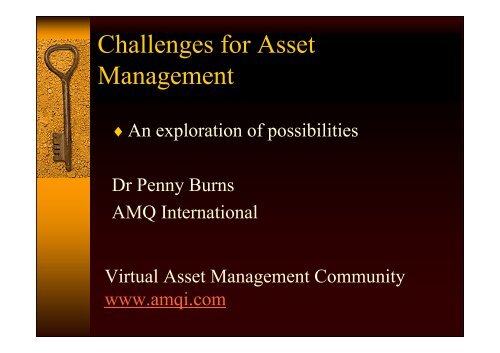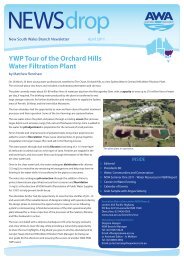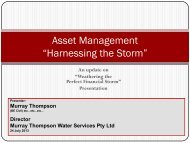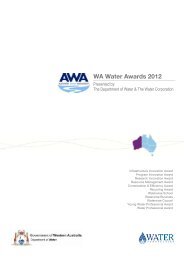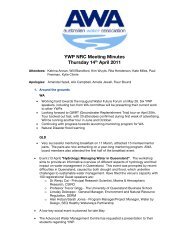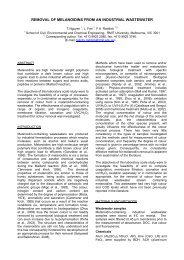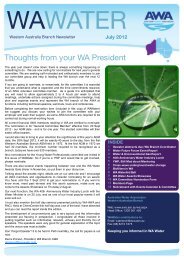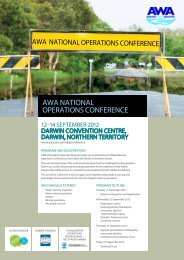Challenges for Asset Management - Dr Penny Burns
Challenges for Asset Management - Dr Penny Burns
Challenges for Asset Management - Dr Penny Burns
- No tags were found...
Create successful ePaper yourself
Turn your PDF publications into a flip-book with our unique Google optimized e-Paper software.
<strong>Challenges</strong> <strong>for</strong> <strong>Asset</strong><strong>Management</strong> An exploration of possibilities<strong>Dr</strong> <strong>Penny</strong> <strong>Burns</strong>AMQ InternationalVirtual <strong>Asset</strong> <strong>Management</strong> Communitywww.amqi.com
The World of <strong>Asset</strong> <strong>Management</strong>has changed Yesterday– The world was different. How different? Today– Where are we now?– Where are we going?– How will we get there?
Yesterday Emphasis on individual assets and shorttermToday Emphasis on asset systems and long termThis has made asset management more holistic inapproach
Yesterday Our focus was project based (eg building abridge)Today Our focus is program based (decisionscenter on the whole lifecycle of assetcollections eg a transport corridor)
Yesterday We considered design and constructionoptionsToday We consider design & construction ANDoperations and maintenance, renewal andreplacement, and eventual disposal asparameters
Yesterday Work was mostly in-houseToday There are more options; e.g. buying servicesrather than assets, contracting out,integrated facility delivery
Yesterday Finance was by government borrowing ortax revenuesToday We have PPP/PFI of incredible variety (andcomplexity)
Yesterday Our approach was piecemeal and ad hocToday We are moving towards a process which isholistic and systematicIn today’s world, input and feedback are essential
So, today we are SYSTEMIC and SYSTEMATICWhat does this mean <strong>for</strong> assetmanagement challenges?
Strategic <strong>Challenges</strong> Alternative arrangements <strong>for</strong> facility(Delivery; Operations & maintenance; Systemsoperation & maintenance)Presents new challenges How do we determine system objectives? How do we evaluate the options? How do we measure and monitor theoutcomes?
Integration <strong>Challenges</strong> Integrating functional and conditiondriven requirements– Functional lives are usually far shorter than physicallives- and less predictable Integrating asset classes and sectors– Services are not provided by one asset class orsector alone – eg rail services with public track,private rolling stock Linking appropriate management anddecision support systems – the problem of reintegratingseparate business units
Measurement <strong>Challenges</strong> Identifying appropriate indicators– The things that REALLY matter <strong>for</strong> servicedelivery (not the things that are easiest tomeasure)– Skills at interpreting indicators in relatedgroups rather than as isolated measures Establishing comparative baselines– Where the context and objectives arecomparable
Analytic <strong>Challenges</strong> Improving data collection and management– Collecting less, updating more Constructing and evaluating alternativelifecycle scenarios– The maintenance/life trade-offs– The maintenance/operation cost trade-offs– The maintenance/service quality trade-offs Incorporate flexibility– Life is changing, models need to change with it
Institutional <strong>Challenges</strong> Effecting coordination between orreconfiguration of silos– E.g. cross functional groups or assetmanagement co-ordinators working from acorporate perspective Defining roles of public and privatesectors– What is core? (Strategy, research, datamanagement?)
Conceptual <strong>Challenges</strong> Clarifying objectives– Defining, measuring and monitoringservice levels Clearly linking activities to outcomes
Accounting <strong>Challenges</strong> Activity based costing– Few can say how much any activity, any service, iscosting. Without this it is not possible to make soundservice decisions – and hence sound assetmanagement decisions(Strategic <strong>Asset</strong> <strong>Management</strong> # 111, April 4 2003) Commitment budgeting– Short term financial planning requires more thansimply knowing what expenses have been accrued, itmeans knowing what have not yet been accrued, buthave been committed
Costing <strong>Challenges</strong> Valuation– Despite much attention, some basic issues still needresolution – e.g. not merely the cost but also the valueof community obligations, the extent to whichreplacement costs builds in inefficiencies, etc– Estimation of value from broad 1-5 condition scales isstill a hit and miss business Depreciation– We need depreciation measures that recognise the fasterdegradation that occurs when maintenance isinadequate
What else?And where to next?Time to Vote! What issues are very important AND youwould like to be involved in their solution? Which issues are pretty important and youwould be pleased if someone else tackledthem? Which are less important, solved, or well ontheir way to solution?
Collaborative Practical Research The web presents the opportunity <strong>for</strong> goodpractical ideas to be developed by groups ofpeople who may be quite distant from eachother geographically– But close in interest and commitment Idea exchange by email or internet is timeeffective – even more so if the exchange is<strong>for</strong>mally facilitated
I shall return! Virtually, that is. Think about the challenges you are facing. I shall write shortly to find the challenges that youwould like to commit to finding a solution to And, where there are viable groups sizes, I willfacilitate research exchange through privatediscussion <strong>for</strong>ums Start thinking! <strong>Penny</strong> <strong>Burns</strong>penny@amqi.com


